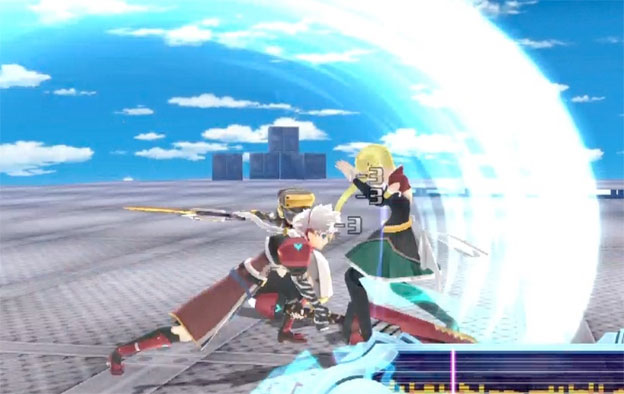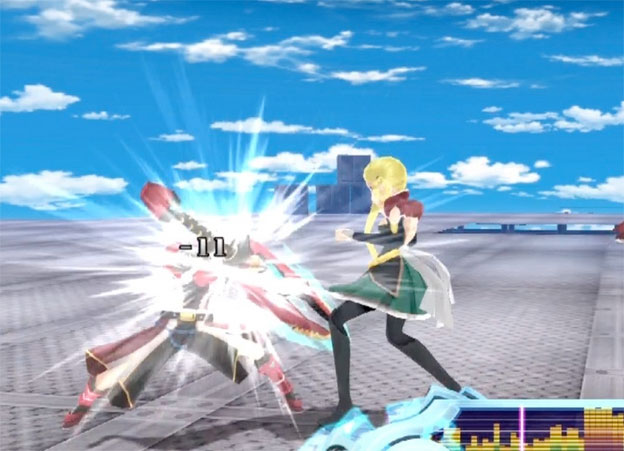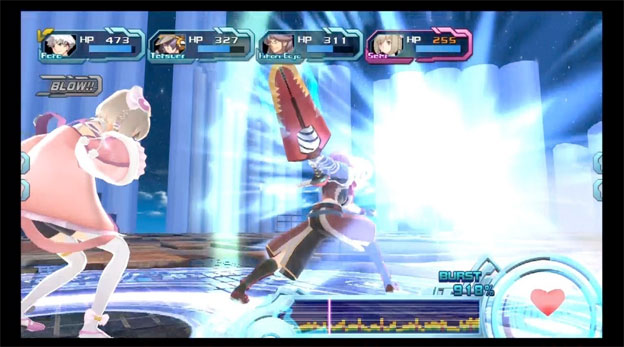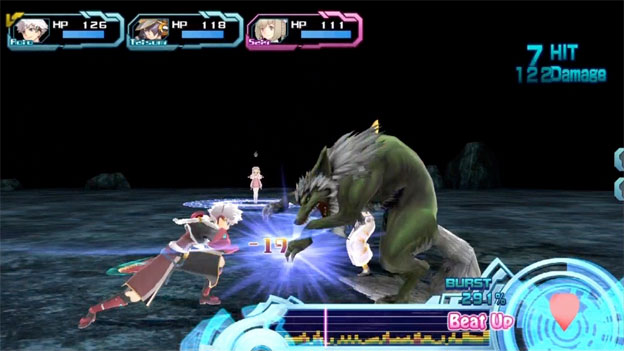Bringing Sexy Back
Ar Tonelico Qoga: Knell of Ar Ciel is the third in a three-game series of Japanese role-playing games set on the tumultuous planet of Ar Ciel. With a candy-colored aesthetic and a tendency toward sophomoric suggestiveness, it continues in the spirit of the first two games but is the first to embrace a 3D approach and to streamline the previous two games’ cumbersome combat systems.
Ar Tonelico Qoga concerns a young steeplejack (which, for those of you who don’t know, is a guy crazy enough to scale the outsides of tall buildings to do repairs) named Aoto. He’s going about his relatively carefree life when on the quiet streets of his hometown, he saves a young girl from being assaulted by soldiers. He discovers the girl is a fugitive and that by helping her, he’s involved himself in a massive, three-way conflict among the planet’s main societies, the core of which is the battle between the human race and an all-female race of machines called Reyvateil. The Reyvateil were created to help humanity but now see them as impure and so harbor an agenda to “cleanse” (brainwash and enslave) them. Saki, the young girl Aoto rescues, is a Reyvateil, but even so, he vows to protect her and return her to her homeland. Along with his anti-social friend Tatsumi, he sets out and his personal journey soon becomes a political campaign that forces him to run like a refugee and fight like a soldier. On the road, he, Saki, and Tatsumi are joined by new allies, a Reyvateil doctor, and another Reyvateil girl named Finnel, and it’s revealed that if the two girls don’t receive treatment for a rare disorder, they won’t live very much longer. Confused? Yeah…and this is the nutshell version.

Despite the convoluted storyline, gameplay in Ar Tonelico Qoga has been simplified, compared to its predecessors. Under the surface, combat is still turn-based but it’s been sped up to feel like real time, and there are fewer “modes” and less screen clutter. In combat you still use parties of four–three humans and one Reyvateil heroine. Humans are out front using melee and ranged weapons, and the heroine is in back, supporting them through Song Magic. A Harmonograph at the bottom of the screen displays the high and low points of the heroine’s song; the idea is to time your attacks to coincide with the high points on the graph. Success in combat is dependent on this graph since it represents the tie between the humans and the heroine. When attacks are matched to the Harmonograph, the heroine’s heart beats faster and when it reaches a certain size, she can execute moves called Purges. The name “Purge” is unfortunate, since it conjures visions of the heroine sticking her finger down her throat, but what it really means is that she can help the humans by healing them, upping their defense and offense, or performing devastating attacks that basically wipe the field of enemies.
An onscreen Burst gauge fills steadily as the battle goes on, and when it gets high enough, Heroines can also execute powerful Burst attacks. This is all pretty cool and comes accompanied by the typical over-the-top visual effects, but here too comes a big part of the game’s cheesy, eighth grade eroticism. For heroines to Purge, they have to take a layer of clothes off. As you progress, you gain the ability to make them Purge up to four times, meaning by the time you’re done, they’re very near naked. The attendant Purge cutscenes feature embarrassing turnarounds of these busty, baby-faced girls posing “sexily” as their clothes vanish and generally ending with a gratuitous bounce. It’s ridiculous and unnecessary, but it’s merely the tip of the iceberg as far as the inclusion of mawkish, grade school sexuality goes. More on that later.

In addition to watching heroines get naked during combat, you can also perform outrageous Super Moves with each human character. You gain access to these via the game’s crafting system (which for some reason is called Image Synthesis). By swapping party leaders during battle, you can perform these moves with each of them and use items like bombs and flamethrowers that can be made by crafting. For most of us RPG lovers, crafting is second only to shopping for upgrades, and the crafting system in Ar Tonelico Qoga is a good part of the fun. You’re awarded raw materials after every battle, and rare ingredients can be found scattered in boxes all over the world. To create something, you go to an Inn or a save point and then choose which of your Reyvateil heroines to assist you. A (skippable) cutscene plays for every item crafted, complete with custom dialogue regarding it, and once items have been crafted, they can be purchased from any of the shops you encounter.

Shops and towns play a big part in the game since they enable you to save, craft, buy things, and rest. Resting also allows you to get to know your heroines by visiting them at night and talking to them. Like a Japanese Jack Tripper in an anime Three’s Company, Aoto gets caught between two lovely ladies, and throughout the game, you’re asked to decide who to chat up the most. Of course, it’s in your best interest to keep them both on the line since the more they like and trust you, the more they can do for you in battle. Getting to know your heroines isn’t just as simple as nighttime chit-chat though. You also have to convince them to let you “Dive” into them. Yes, the sexual innuendo is absolutely intentional here, and there’s a ton of goofy build-up around the girls “giving up” their first Dive to Aoto and the fact that he’s Diving into more than one of them.

In actuality, Diving isn’t at all physical, but entails Aoto and the heroines going to a Dive shop in town and climbing into separate mechanical pods. The process allows Aoto to dive into a girl’s mind and help her overcome her fears by investigating the various facets of her psyche. In truth, it represents the most fun you’ll have in the game as you get to explore a wide range of weird, surreal places and meet a number of different characters who represent the heroine’s different personae. You’ll also unlock powerful “Hyuma,” spunky little fairies who can be manually programmed into the heroines’ minds, allowing them to access different buffs and heals during combat. Programming is related to resting and involves visiting a heroine and talking her into letting you do it. Absurdly, this is another area where things work better if the girls strip, and it’s up to you to schmooze them into doing it by talking pretty and bringing them gifts.
Overall, Ar Tonelico is entertaining and offers some fresh ideas on some fairly stale RPG conventions. It’s also a beautiful game, with gorgeous painted backgrounds and attractive characters. The downside? Well, for one thing, big chunks of the soundtrack will make you wish you had a pair of those expensive, noise-canceling headphones. During combat, or when certain characters appear, the music goes into these horribly manic, ear drum bursting, knock-off Marilyn-Manson kind of themes that are outright bad. Then there’s the issue of unavoidable random battles; many RPGs have outgrown this obnoxious mechanic, but Ar Tonelico Qoga apparently hasn’t. In the travel sequences, you can’t go twenty steps without a battle and while you can flee these battles and not get stuck fighting them, you still have to put up with being stopped every ten seconds. Worse than that though, are the ridiculously suggestive parts of the game. It’s like they hired a team of fourteen-year olds to write the script and all the eye-rolling excuses for partial nudity and contrived lines such as, “I can feel something coming inside me!” are, paradoxically enough, a big turnoff.
Even with these problems, Ar Tonelico Qoga: Knell of Ar Ciel is a polished, pretty game that offers an interesting (if labyrinthine and melodramatic) storyline, a fun crafting system, and the kind of bombastic visual effects lovers of JRPGs have come to expect. It also represents a relatively accessible example of the genre, one simple enough for new gamers to easily learn but complex enough to avoid alienating the JRPG veterans.
RATING OUT OF 5 RATING DESCRIPTION 4.5 Graphics
In keeping with the graphic standards of the Japanese RPG, both characters and backgrounds are stunning. 4.0 Control
Controls are surprisingly simple and easy to use. 3.0 Music / Sound FX / Voice Acting
The sound overall is well done, but the wannabe heavy metal music is terrible. 3.5 Play Value
Despite the silly sexual overtones and pesky random battles, the game offers plenty of fun and adventure. /div> 4.0 Overall Rating – Great
Not an average. See Rating legend below for a final score breakdown.
| Review Rating Legend | |||
|---|---|---|---|
| 0.1 – 1.9 = Avoid | 2.5 – 2.9 = Average | 3.5 – 3.9 = Good | 4.5 – 4.9 = Must Buy |
| 2.0 – 2.4 = Poor | 3.0 – 3.4 = Fair | 4.0 – 4.4 = Great | 5.0 = The Best |
Game Features:
